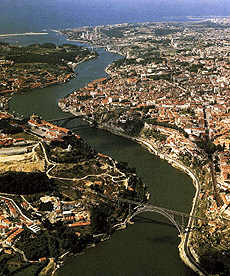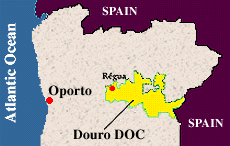Port is a fortified wine from the remote vineyards in Portugal's Douro Valley. Here, in the Douro Valley, time has almost stood still. You will not find the latest wine making techniques and fancy equipment. Instead, you will find a wine industry much the way it was over a hundred years ago. Yet, in spite of it, or because of it, vintage Port is one of the world's greatest wines.
Port takes its name from the city of Oporto that is situated at the mouth of the 560-mile long Rio Douro or River of Gold. Although many port-style wines are made around the world – most notably Australia, South Africa and the United States – the strict usage of the terms Port or Porto refer only to wines produced in Portugal. It is these wines that we will explore here.
Pronunciation Guide
Baixo-Corgo [BY-shoe-Korgo]
Barcos rabelos [BAR-kos ha-BEL-os]
Cima-Corgo [SEEMA-korgo]
Colheita [col-YATE-a]
Engarrafadores [engarra-fa-DOR-ez]
Lagar [la-GAR]
Porto [PORT-o]
Quinta [KEEN-ta]
Tinto [TEEN-toe]
Touriga Nacional [too-REE-gah na-SHUN-al]
Tinta Roriz [teen-ta HOR-eez]
Vinha [VEEN-yah]
The History of Port
The history of Port begins in the 17th-century. The Portuguese of course, had been making wine for hundreds of years since the Romans introduced wine to the Iberian Peninsula in the first century B.C. And they were making quite a bit of it. By the beginning of the 17th-century, they were shipping as many as 1,200,000 cases of wine down the Douro River to Oporto each year. From there it was sold throughout Portugal, to the Dutch, and to the British. But it was the geopolitics of Europe in the middle of the 17th-century, that caused the British to develop Portuguese wine into port.
In 1678 Britain declared war on France and blockaded French ports. This created an instant shortage of wine. Britain has been the traditional trading partner and ally of Portugal since 1373 when an agreement was signed pledging "perpetual friendship." It was natural then, that the British wine merchants turned to Portugal to find an alternative to the French wines they preferred. Unfortunately, wines of the quality they were looking for were not readily available. Wine making in Portugal had not become the serious endeavor it was in France. So if the British wanted good wine, they were going to have to oversee its production themselves. And this they did.
Traveling inland along the Douro River, they found darker and more astringent red wines in contrast to those they had seen near the coast. In order to stabilize them for shipment to England, merchants added "a bucket or two" of brandy to the barrels of wine before sending them off. This early wine from Oporto was not highly praised back in London. Any popularity it enjoyed was due more to its availability than anything else. As a result, sales fluctuated with the warming and cooling of Britain's relations with France.
The opening of the 18th-century brought with it the War of Spanish Succession. Britain and France were once again on opposing sides. In 1703, Britain and Portugal signed the Methuen Treaty providing for, among other things, bolts of cloth from England for pipes of wine from Portugal. This paved the way for the enormous expansion of port trade in the 18th and 19th-centuries.

No one knows exactly when port, as we know it, was created. The first wine from Oporto was really just red table wine. A story is told of a wine merchant in Liverpool, who in 1678, sent his sons to Portugal to find a wine source. In the Douro Valley they came upon a monastery in Lamego. The abbot was adding brandy to the wine during rather than after fermentation thereby producing a port-type wine. In any event, sometime during the end of the 1600's or beginning of the 1700's, someone came up with the idea of stopping the fermentation with brandy while the wine was still sweet, fruity, and strong.

All was going well until in the 1730's, the port industry was faced with scandal. The prospect of easy gains caused some of the less scrupulous vintners began to add sugar and elderberry juice to give sweetness and color to otherwise overstretched wines. Inferior wine and overproduction caused the price of port to fall. To cope with all the complaints and accusations, the Marquês de Pombal created the Old Wine Company. Its creation, while greatly improving quality, effectively ended the virtual monopoly of the British. This new company had far-reaching powers. It was in its charter to regulate the quantities produced, fix the maximum and minimum prices for both buying and selling, and arbitrate all disputes. It also set up in 1756, the growing region for the production of port. All vineyards outside of this official region, along with all of the elderberry trees in northern Portugal were uprooted.
For the rest of the 18th-century, the Port industry struggled to rebuild the port trade with Britain. By the mid-1900's, Portugal was shipping about 3 million gallons of port per year to Britain. The major port houses we know today had been established — Warre, Croft, Taylor, Sandeman, Offley Forrester, Kopke, van Zeller, Burmester, Graham, Guimaraens, Cockburn, and Dow. This was the "Golden Age of Vintage Port" and in it many vintages were declared. The last great vintage of these years was 1878. Then phylloxera, the root louse that was devastating Bordeaux, Burgundy, and other vineyards in Europe, came to the Douro Valley. By grafting their vines to American rootstock they were able to turn the tide. By 1890, most all of the vineyards were replanted in this way or not at all. But they were now ready for some great years in the 20th-century.
Since the phylloxera, the port houses have declared fewer vintages, but the quality is better. Today, both local and domestic investment in the region is focused on quality not quantity. More and more people are discovering port. The French drink the most port in general, but the British and secondly, the Americans, consume the most vintage port.
Regions
The Douro Valley was probably the world's first officially demarcated wine region. It is no doubt the world's most difficult wine growing region. Demarcated in 1756, it is a region that spreads out over 618,000 acres. Of this area, there are only 10 to 12% or approximately 82,000 acres, of cultivated vine planted on the harsh, rugged mountains that rise up from the Douro River and its tributaries. At times the inclination increases from 35% up to 70%. Some grapes are grown as far up as 1800 feet, but the best grapes are grown at the lower elevations. There is a local saying that the best port comes from the grapes that can hear the river flowing.
The region, referred to locally as "the Douro," begins at the Serra do Marão, a range of mountains 40 miles inland, and extends almost 100 miles to the Spanish border. At its widest point it measures only 16 miles. The mountains create a weather barrier, sharply cutting the rainfall that is received to the east of them. The climate of the Douro becomes one of extremes. The summers are extremely hot and dry often reaching 110°F, and the winters can be quite cold as the mercury sometimes drops below 0°F.
The Serra do Marão mountain range was for so long an obstacle, that the region has always been a remote one — a feeling and look it still retains to this day. Settlements are few and far between. Transportation and communications require patience.
There is almost no soil on these mountains. What is there is a hard schist that retains little water and features few nutrients. In fact, it is very acidic due to high potassium and low calcium and magnesium content. And it contains excessive aluminum which is toxic to the roots. But man's fierce dedication, determination and hard work has turned what might look like a lunar landscape, into a first class wine growing region.
Over a period of 300 years, a gritty, choking, soil has been created by smashing up the schistose rocks to a depth of three feet. The sides of the mountains have been fashioned into terraces most often by the use of pointed iron tools and dynamite. Grape vines cling to these terraces and follow the contour of the mountain. Their search for water may push the roots down 65 feet through the fissures in the schist. This is truly a wine born of adversity.
The Port wine region is divided into three sub-zones — the Baixo (lower) Corgo, the Cima (higher) Corgo, and the Douro Superior. The three regions are determined by natural conditions. The westernmost Baxio Corgo is the smallest region, yet due to its close proximity to the Atlantic ocean it gets the most rainfall, is the most fertile, and thus is the most abundant. It tends to produce the lightest wines like ruby and tawny ports. It produces almost 50% of all port made.
Upstream, the Cima Cargo is more than double in size with approximately 235,000 acres. About 14% is planted with vines. This sub-zone is demarcated from where the Corgo River intersects the Douro to the Cachão de Valeira Gorge. Here, where rainfall is significantly less – about 28 inches a year – is where most of the high quality tawny, LBV, and Vintage port is made. Surrounding the town of Pinhão, are most of the famous wine growing properties or quintas. This region accounts for about 36% of the port produced.
The last region is the Douro Superior and extends to the Spanish border. It is the largest of the three sub-zones with 271,700 acres. It is the most arid and the least developed. Only about 13% of all port is produced here. It will be interesting to see what developments will come to this zone in the years ahead.





